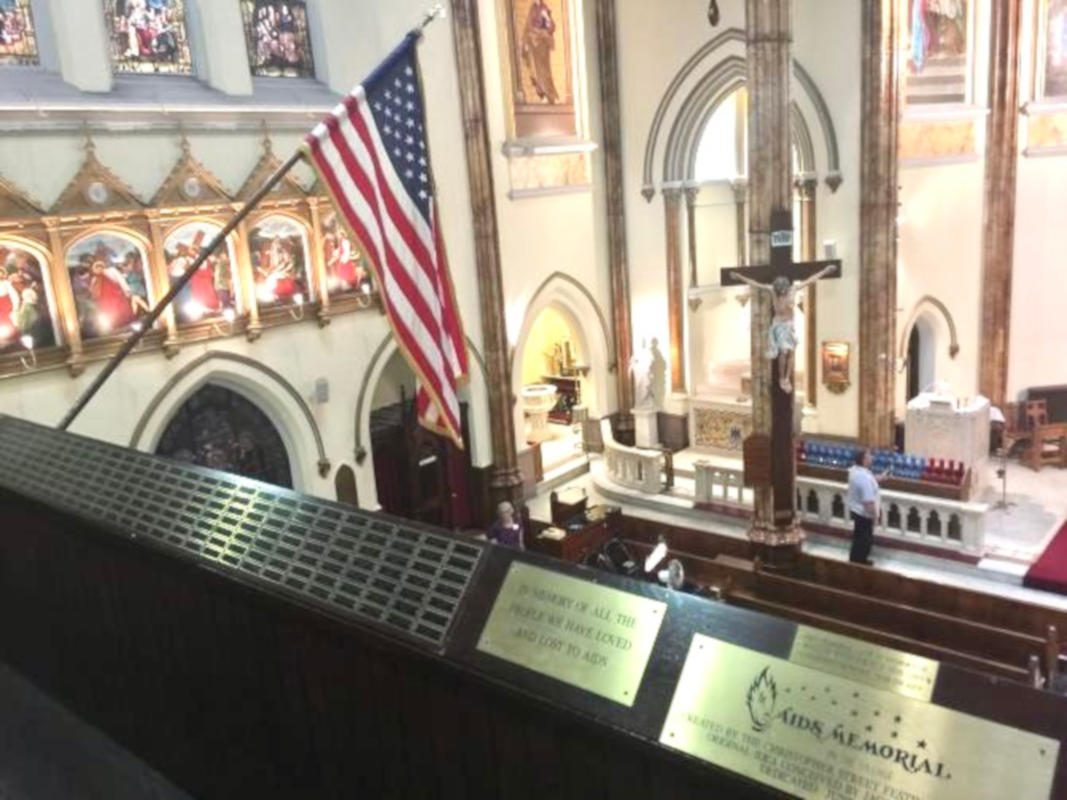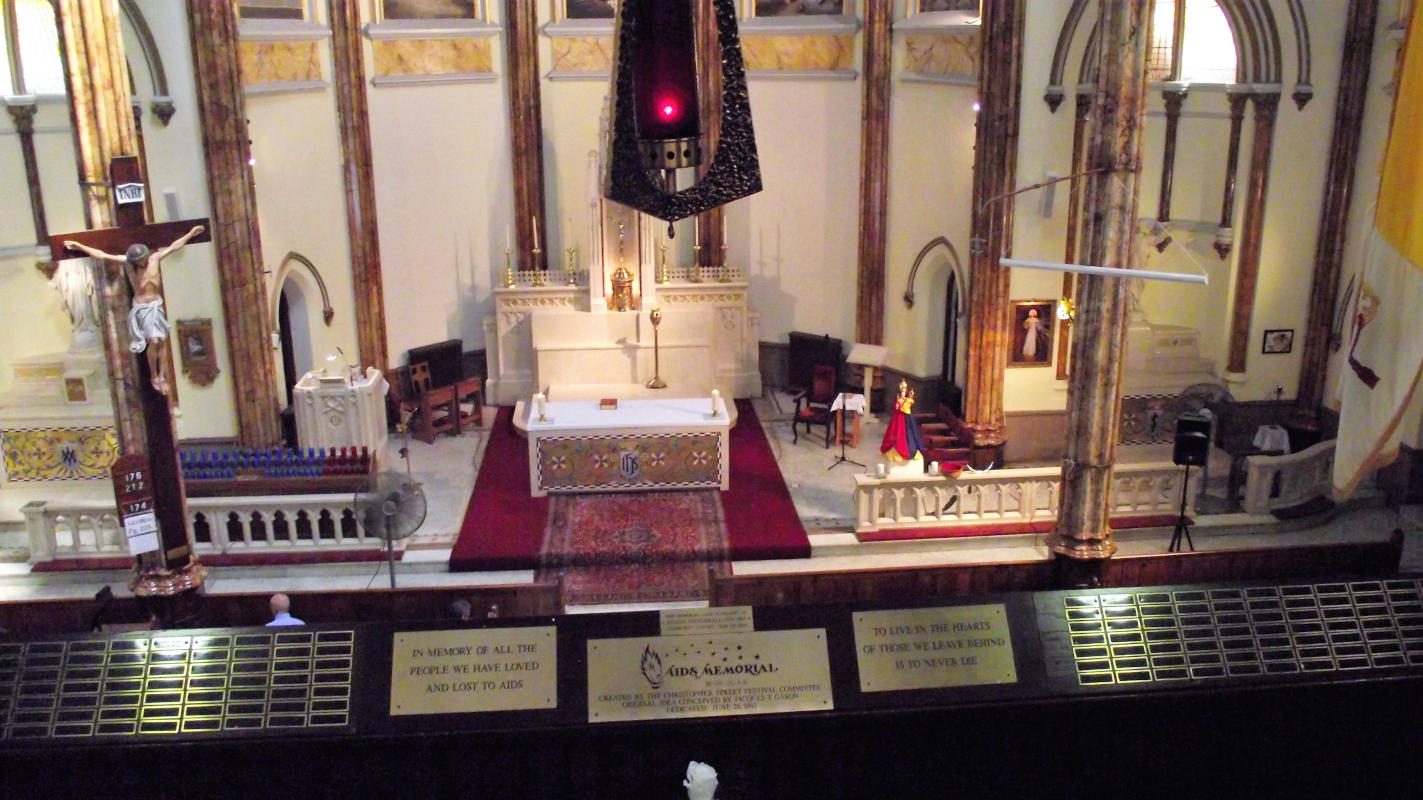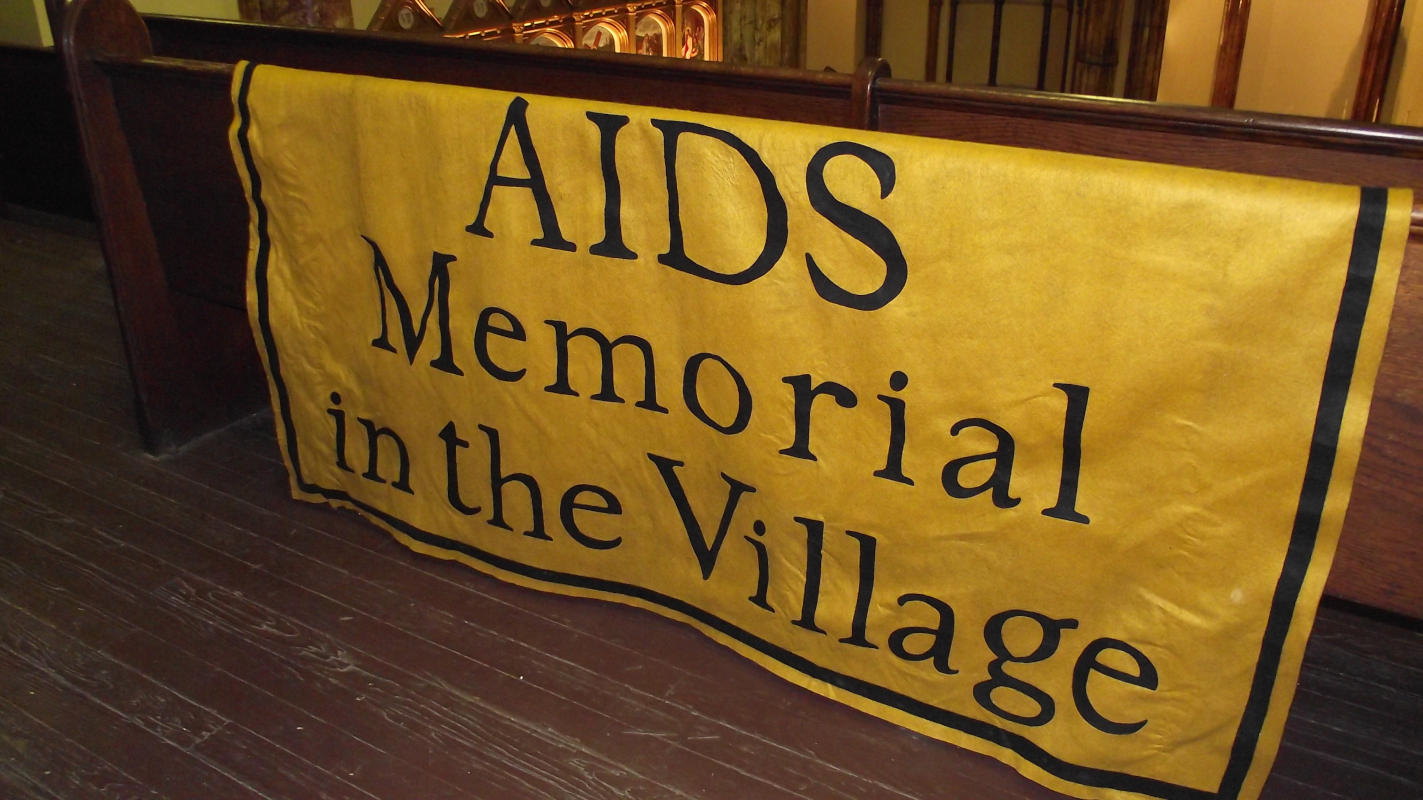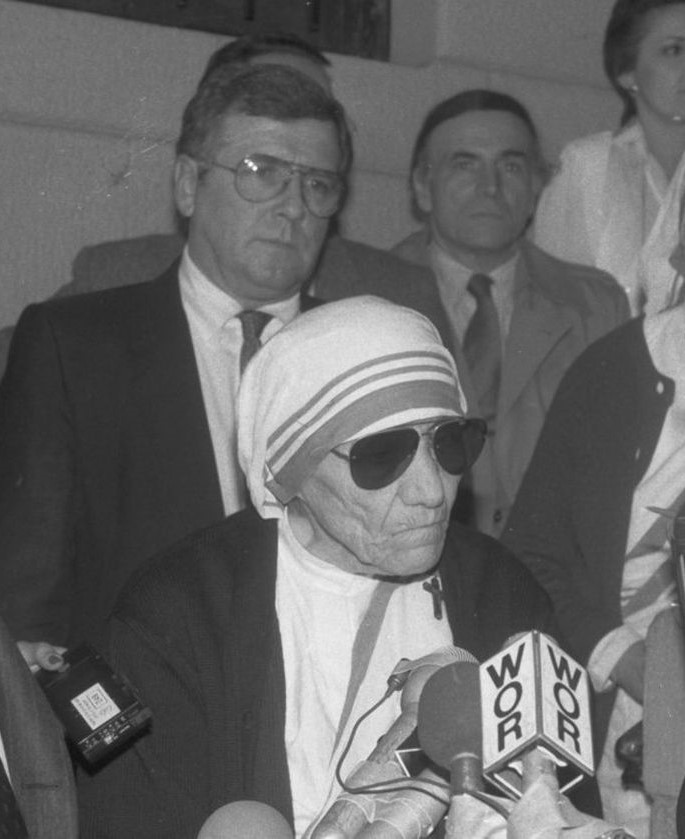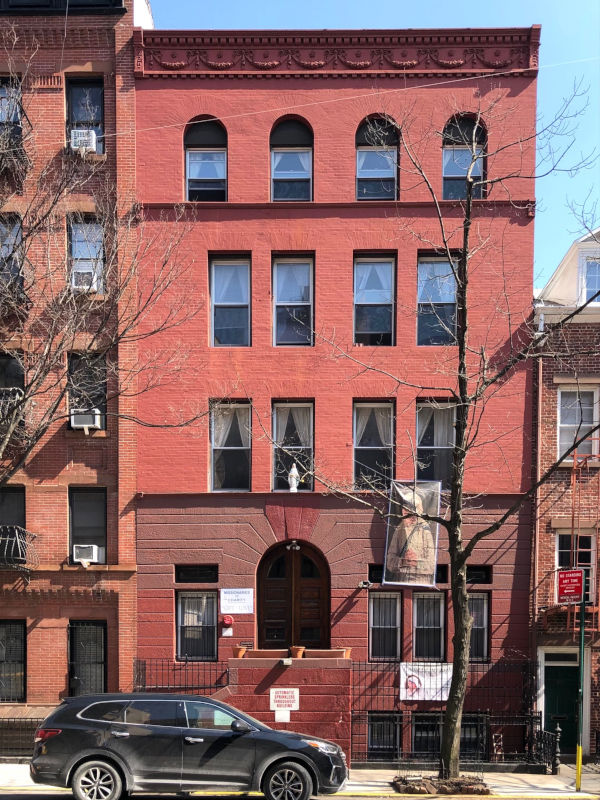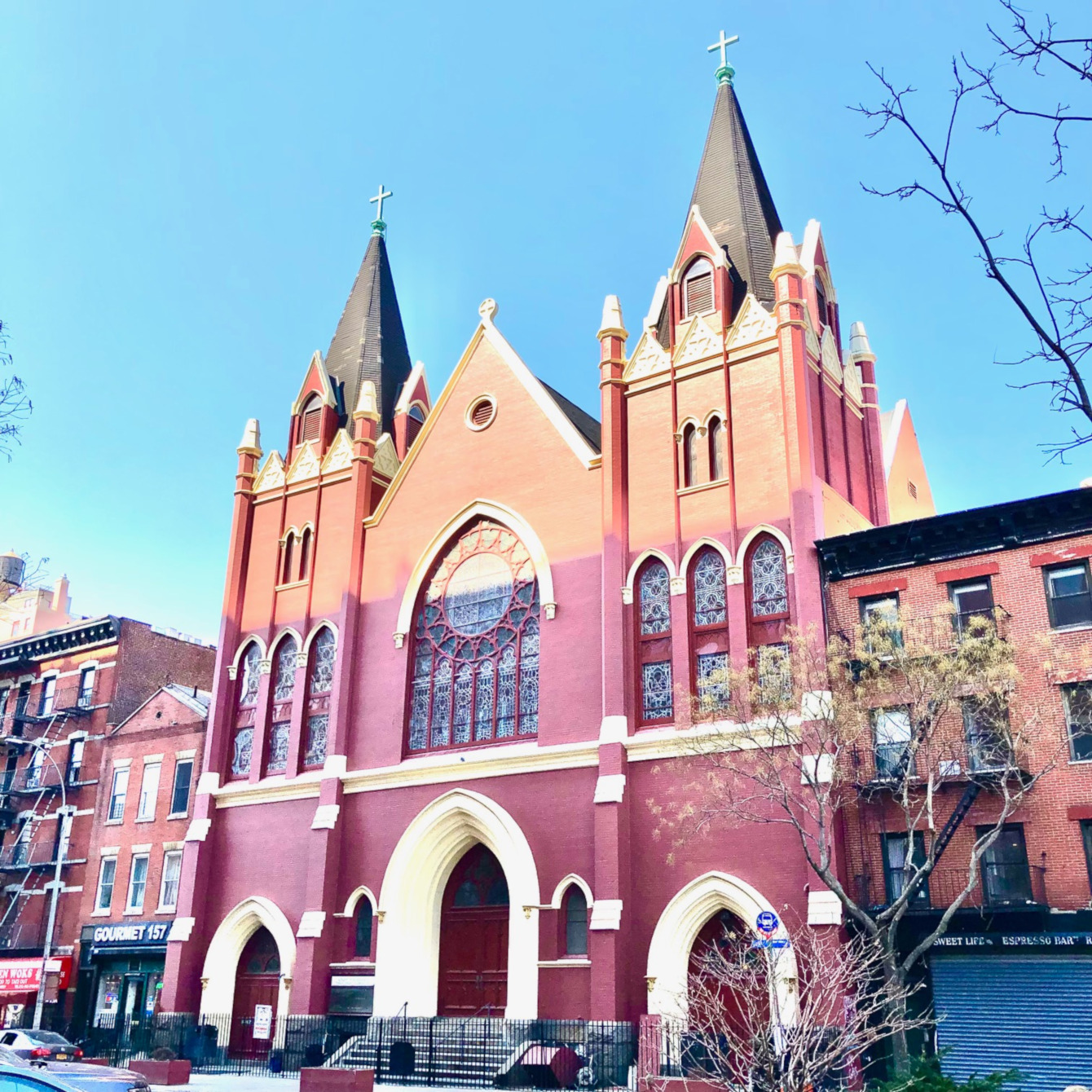
Village AIDS Memorial at St. Veronica’s Roman Catholic Church
overview
The Village AIDS Memorial, one of the first public memorials in the city to recognize the epidemic, was officially dedicated at St. Veronica’s Roman Catholic Church in 1992 (as of 2022, the memorial is threatened with being removed and relocated).
The nearby rectory housed one of the city’s first AIDS hospice centers that was opened in 1985 by the Missionaries of Charity, founded by Mother Teresa.
History
During the AIDS epidemic in the 1980s and 1990s, the parish of St. Veronica’s Roman Catholic Church demonstrated an unusual example of compassion and outreach at a time of religious hostility and AIDS-phobia towards the LGBT community. This was due, in large part, to the Rev. Kenneth Smith, who became rector in 1990 and wanted to provide religious support to the congregation, which, given the church’s location in Greenwich Village, included a large percentage of LGBT parishioners.
The Rev. Smith was one of the few Roman Catholic clergy to provide pastoral counseling and sacraments to people with HIV and those dying from AIDS. On June 26, 1992, the Village AIDS Memorial, located in the choir loft and consisting of individually donated metal plaques with the names of people who died from AIDS, was officially dedicated at an interfaith service recognizing the epidemic. This annual interfaith service began in the church the year prior and continued until 2015.
The idea for the memorial came from the organizers of the AIDS Candlelight March and Vigil, which began in 1985 and was sponsored by the Christopher Street Festival Committee. According to activist Brendan Fay, the key to understanding the importance of the vigil and memorial is to recognize the “human longing and need for the community to grieve, and to remember, with dignity, the lovers and friends who died, and to honor the trauma of the loss and death of so many.” The installation of the memorial was controversial for multiple reasons. Some in the congregation were opposed to the parish’s focus on AIDS ministry and some in the LGBT community felt that a memorial should not be located in the church, let alone in an abandoned, difficult-to-access balcony, due to the Archdiocese’s anti-gay policies and dogma. (Initial locations that were considered for the memorial included the waterfront near Christopher Street, Christopher Park, Bailey-Holt House, and the LGBT Community Center.) The church’s ongoing AIDS ministry and large LGBT congregation caused some parishioners to leave. During this period, the church basement was redesigned and renovated with the financial support of LGBT people who attended weekly Gay Bingo fundraisers, organized by Fay. The new space was called “The Meeting Place” where daily LGBT Twelve-Step and community meetings were held; it became known as “The Twelve Step Center of the Village.”
Today, the memorial, one of the first to publicly recognize the AIDS epidemic in the city, comprises 580 plaques, including the names of many in the congregation who died from AIDS. In 2017, the New York Archdiocese closed the building for services and the congregation then petitioned the Roman Curia at the Vatican to reverse this relegation. As of 2022, the congregation awaits the church’s reopening. The Archdiocese is currently planning to remove and relocate the memorial to a nearby parish, but it is unclear where and how the memorial will be displayed and maintained (the church cannot be demolished since it is within a designated New York City historic district). Other public New York City memorials dedicated to the AIDS crisis include the National AIDS Memorial at St. John the Divine, the New York AIDS Memorial in Hudson River Park, and the NYC AIDS Memorial at St. Vincent’s Triangle.
The first Annual AIDS Candlelight Vigil and March, organized by the Christopher Street Festival Committee, took place in 1985 outside of the church. By 1991, the march, which was meant “to honor the dead and support the living,” went from Christopher Park to the street in front of the church. In 1993, due to controversy surrounding the vigil and march organizers, Fay, along with activist Randy Wicker and members of the faith and community groups, organized an alternative vigil outside the church.
The street in front of the church has also been the site of protest. In the fall of 1987, ACT UP, joined by the Coalition for Lesbian and Gay Rights, protested the visit of Cardinal John O’Connor to the church. O’Connor was the target of protest due to his homophobic and AIDS-phobic positions. Eight years later, on the eve of Pope John Paul’s arrival in New York City on October 4, 1995, members of the LGBT community gathered for a “Vigil of Solidarity” at the LGBT Community Center, followed by a candlelight procession to St. Veronica’s.
The church rectory, located around the corner at 657 Washington Street, has its own significance as an LGBT historic site. In 1985, it became one of the first hospice centers in the city for people with AIDS. This was at a time when the Roman Catholic Archdiocese of New York created lethal obstacles to mitigating the spread of HIV with its anti-LGBT doctrine and stance against the distribution of condoms. The Archdiocese originally planned to open the hospice in a former convent on the Upper West Side, but those plans were canceled due to hostility from the congregation and community. The rectory of St. Veronica’s was selected due to its location in Greenwich Village, a less hostile neighborhood.
On Christmas Eve 1985, the Gift of Love AIDS Hospice was officially opened by Mother Teresa whose Missionary of Charity staffed the 14-bed facility with assistance from church volunteers. It provided care to approximately 200 people with AIDS, mostly homeless and people of color. Many were individually recognized with plaques at the Village AIDS Memorial. The order continues to provide services from this building.
Entry by Ken Lustbader, project director (April 2022).
NOTE: Names above in bold indicate LGBT people.
Building Information
- Architect or Builder: John J. Deery
- Year Built: 1890 and 1902-03
Sources
“AIDS Memorial In St. Veronica’s Causes Dispute,” The Villager, June 3, 1992, accessed March 14, 2022, bit.ly/3CGVy16.
“AIDS tests the Faith of some congregations,” The Villager, April 7, 1999, accessed March 14, 2022, bit.ly/35XjrFJ.
Andy Humm, e-mail exchange with Ken Lustbader/NYC LGBT Historic Sites Project, April 2022.
Brendan Fay, e-mail with Ken Lustbader/NYC LGBT Historic Sites Project, March 2022.
Jay Blotcher, phone call with Ken Lustbader/NYC LGBT Historic Sites Project, April 2022.
Jay Shockley, Greenwich Village Historic District Extension Designation Report (New York: Landmarks Preservation Commission, 2006).
Michael J. O’Loughlin, “Hidden in a New York choir loft, an early AIDS memorial faces an uncertain future,” America: The Jesuit Review, July 28, 2017, accessed March 14, 2022, bit.ly/3w5K7yA.
Robert Shine, “AIDS Memorial in New York May Be Dismantled Due to Parish Closing,” New Ways Ministry, August 25, 2017, accessed March 14, 2022, bit.ly/3InF2Vb.
“St. Veronica’s, 149 Christopher Street, Saved,” Village Preservation, May 28, 2021, accessed March 14, 2022, bit.ly/36n7ide.
Terri Cook, e-mail with Ken Lustbader/NYC LGBT Historic Sites Project, March 2022.
Village AIDS Memorial, accessed March 14, 2022, bit.ly/3CIPMfe.
Do you have more information about this site?
This project is enriched by your participation! Do you have your own images of this site? Or a story to share? Would you like to suggest a different historic site?
